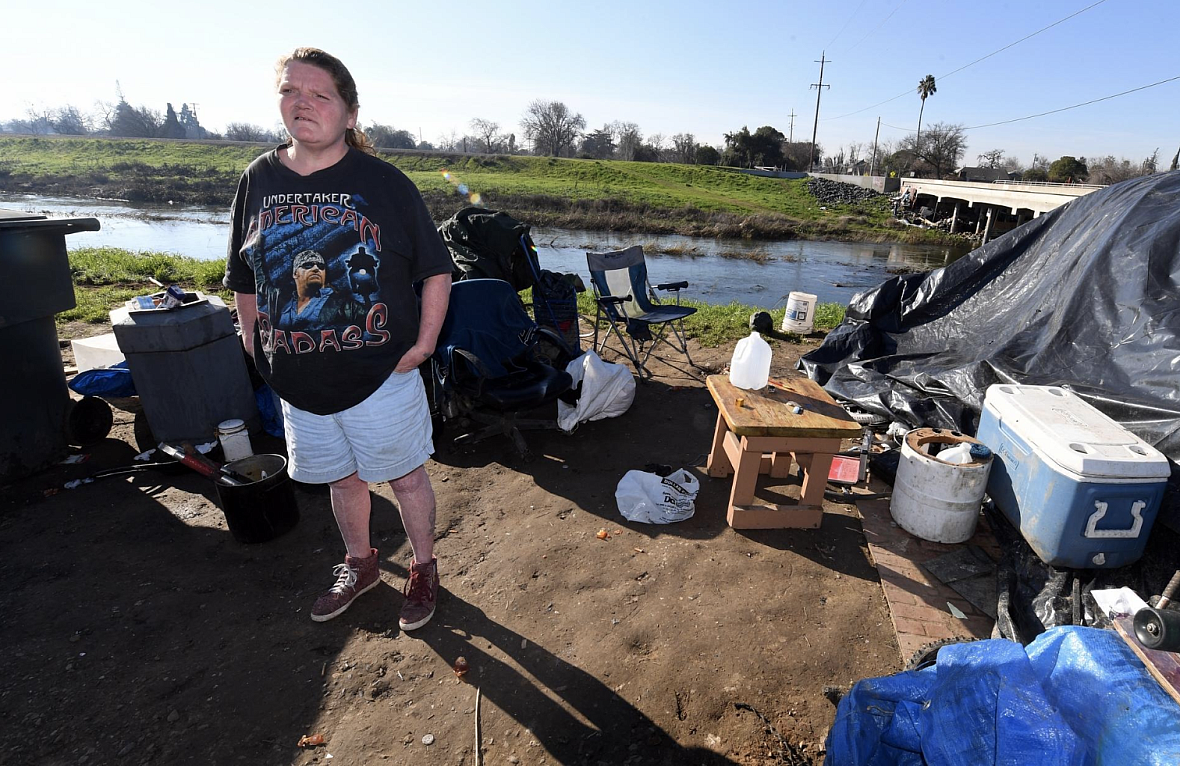Navigating the health care maze can be daunting
This article was produced as a project for the USC Center for Health Journalism’s 2018 Data Fellowship.

For those like Becky Walthan, whose health problems are made worse by the fact that she is homeless, navigating the healthcare system is challenging, even with safety nets in place for vulnerable populations.
(Photo Credit: Calixtro Romias/The Record)
STOCKTON — Becky Walthan lives with several serious health conditions, including psoriasis, a chronic skin condition that causes inflammation and red patches.
The 45-year-old Stockton woman’s problems are made worse by the fact she lives in a tent clinging to the side of a canal bank.
Walthan would like to move inside — especially since it’s been so cold and stormy lately — but says shelter conditions are unbearable and “I’m safer out here.” Motel rooms are too expensive and getting enough money together to rent something longer term is out of reach on her meager assistance check.
Despite the hardships, Walthan considers herself lucky. She knows how to access health care. Between safety net resources including Medi-Cal, Health Plan of San Joaquin and Community Medical Centers, Walthan says she does OK taking care of her medical problems.
Dealing with the health care system has never been easy. For those with a basic education, solid grasp of English, a job offering access to health insurance, and some savings or regular income, you’ve already cleared some of the hurdles.
There’s finding the right doctor, making an appointment, getting to the appointment, filling out forms on your current health and medical history, getting a release of medical information, making the most of your time with the doctor during the appointment, paying for the appointment, carrying out follow-up instructions and going to a pharmacy for prescriptions (if needed).
Second nature for some, daunting for many others.
“Given the highly fractured and — to many — inscrutable nature of the U.S. health care sector, this process is fraught with challenges for most consumers, especially those who are sick, stressed, busy with their everyday lives or otherwise disadvantaged in taking on the tasks involved,” according to AcademyHealth’s “Navigating Health Care: Why It’s So Hard and What Can Be Done to Make It Easier for the Average Consumer” issue brief.
“For patients to get timely, appropriate, affordable and quality care, they must be able to navigate the health care system. When it is too burdensome, patients and their caregivers respond by delaying or failing to get needed care or by seeking care in inappropriate but more easily accessible settings, such as emergency departments,” the brief continued.
It takes a lot of time to explain how the health care system works to patients and their caregivers with limited English proficiency. There are numerous forms that need to be read and understood. People often sign those forms whether or not they understand them.
“Despite the system’s effort to make things clear up front, the complexity of most situations leads to problems or miscommunications that need to be untangled later,” AcademyHealth stated.
For the poor, the uninsured, the homeless, recent immigrants, people with physical disabilities or mental impairments, there is the health care safety net — the resources and providers that organize and deliver a significant level of health care and other related services to vulnerable populations.
“People don’t know what to do,” said 55-year-old Muhammad Sultan, an emigrant from Pakistan who arrived in Lodi in 2010.
Unable to find a job for someone with his background, a college graduate with a master’s degree in geography who worked as a high school principal in his homeland, Sultan now works in a friend’s smoke shop as a low-paid clerk with no benefits.
He qualifies financially for Medi-Cal benefits for himself, his wife and their three children and is enrolled through Health Plan of San Joaquin for coordinated, managed care, crediting his education and English comprehension for getting into the system.
He is quite happy with the health care both he and his family receive.
In the region covered by Health Plan of San Joaquin — all of San Joaquin and Stanislaus counties — 41 percent of all residents have Medi-Cal coverage. That is more than 536,000 people. Of those, 58 percent are families with children; 63 percent of adults are in the labor force; and 17 percent of adults do not have a car.
But for many Pakistani immigrants in the county, Sultan said, “they need to know this information” concerning their options for health care.
“Nobody’s outside the system,” Sultan believes, “but they just don’t know what to do.”
Sultan is right up to a point. An immigrant who meets all eligibility requirements — but is not in a satisfactory immigration status for full scope Medi-Cal — is entitled to emergency and pregnancy-related services and, when needed, state-funded long-term care, according to the California Department of Health Care Services that administers Medi-Cal.
[This story was originally published by The Record.]

